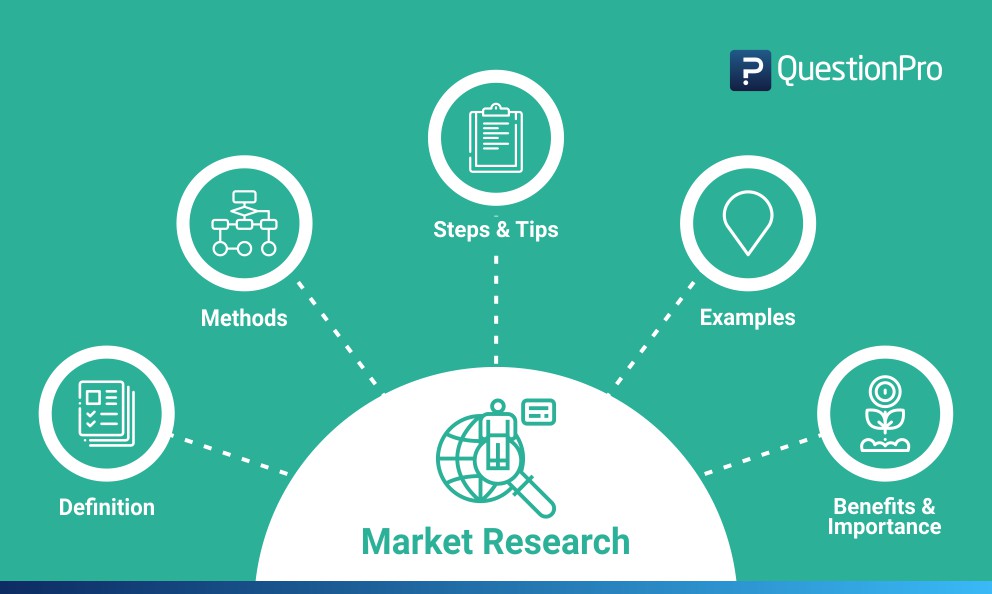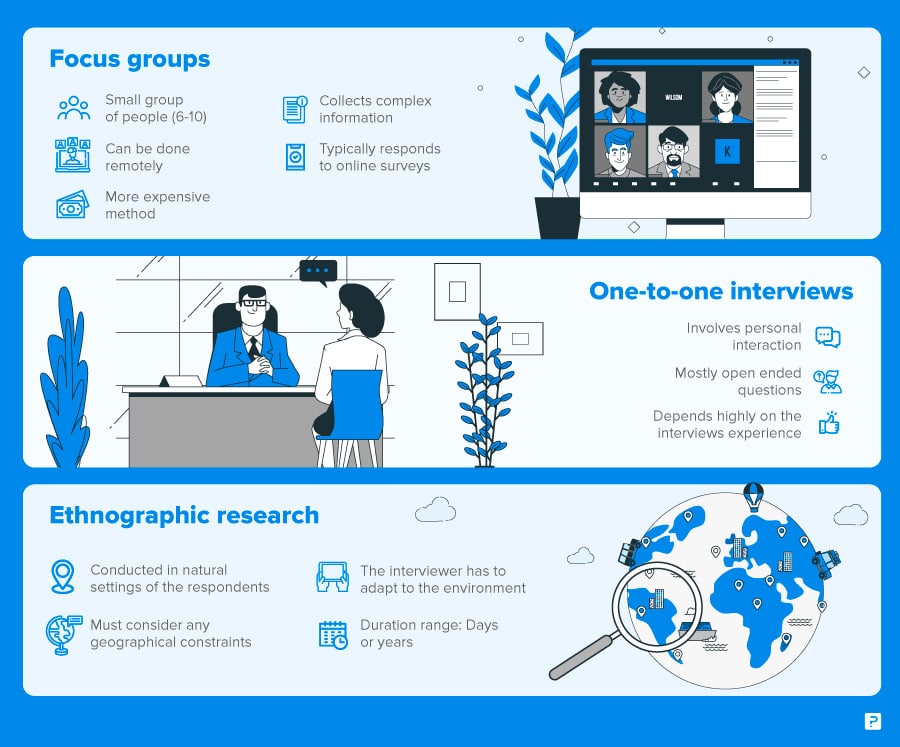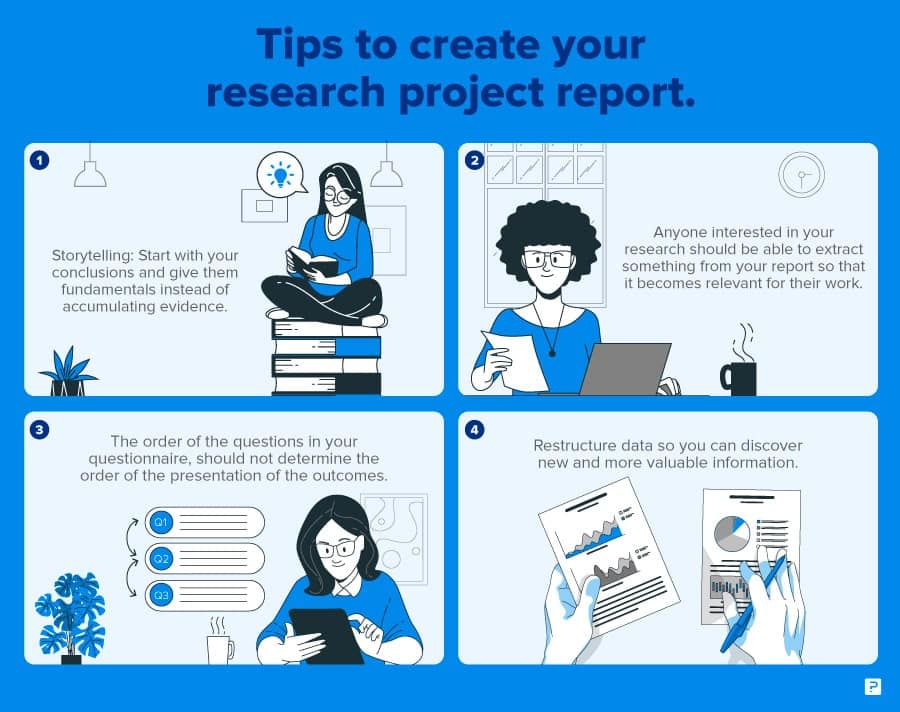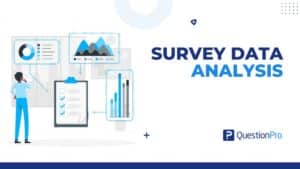
Would you like to know why, how, and when to apply market research? Do you want to discover why your consumers are not buying your products? Are you interested in launching a new product, service, or even a new marketing campaign, but you’re not sure what your consumers want?
To answer the questions above, you’ll need help from your consumers. But how will you collect that data? In this case and in many other situations in your business, market research is the way to get all the answers you need.
In this ultimate guide about market research, you’ll find the definition, advantages, types of market research, and some examples that will help you understand this type of research. Don’t forget to download the free ebook available at the end of this guide!
What is Market Research?
Market research is a technique that is used to collect data on any aspect that you want to know to be able to later interpret it and, in the end, make use of it for correct decision-making.
Another more specific definition could be the following:
Market research is the process by which companies seek to collect data systematically to make better decisions. Still, its true value lies in the way in which all the data obtained is used to achieve a better knowledge of the market consumer.
The process of market research can be done through deploying surveys, interacting with a group of people, also known as a sample, conducting interviews, and other similar processes.
The primary purpose of conducting market research is to understand or examine the market associated with a particular product or service to decide how the audience will react to a product or service. The information obtained from conducting market research can be used to tailor marketing/ advertising activities or determine consumers’ feature priorities/service requirements (if any).
LEARN ABOUT: Consumer Surveys
Why is market research important?
Conducting research is one of the best ways of achieving customer satisfaction, reducing customer churn and elevating business. Here are the reasons why market research is important and should be considered in any business:
- Valuable information: It provides information and opportunities about the value of existing and new products, thus, helping businesses plan and strategize accordingly.
- Customer-centric: It helps to determine what the customers need and want. Marketing is customer-centric and understanding the customers and their needs will help businesses design products or services that best suit them. Remember that tracing your customer journey is a great way to gain valuable insights into your customers’ sentiments toward your brand.
- Forecasts: By understanding the needs of customers, businesses can also forecast their production and sales. Market research also helps in determining optimum inventory stock.
- Competitive advantage: To stay ahead of competitors market research is a vital tool to carry out comparative studies. Businesses can devise business strategies that can help them stay ahead of their competitors.
LEARN ABOUT: Data Analytics Projects
Types of Market Research: Market Research Methods and Examples
Whether an organization or business wishes to know the purchase behavior of consumers or the likelihood of consumers paying a certain cost for a product segmentation, market research helps in drawing meaningful conclusions.
Depending on the methods and tools required, the following are the types:
1. Primary Market Research (A combination of both Qualitative and Quantitative Research):
Primary market research is a process where organizations or businesses get in touch with the end consumers or employ a third party to carry out relevant studies to collect data. The data collected can be qualitative data (non-numerical data) or quantitative data (numerical or statistical data).
While conducting primary market research, one can gather two types of information: Exploratory and Specific. Exploratory research is open-ended, where a problem is explored by asking open ended questions in a detailed interview format usually with a small group of people, also known as a sample. Here the sample size is restricted to 6-10 members. Specific research, on the other hand, is more pinpointed and is used to solve the problems that are identified by exploratory research.
LEARN ABOUT: Marketing Insight
As mentioned earlier, primary market research is a combination of qualitative market research and quantitative market research. Qualitative market research study involves semi-structured or unstructured data collected through some of the commonly used qualitative research methods like:

-
Focus groups:
Focus group is one of the commonly used qualitative research methods. Focus group is a small group of people (6-10) who typically respond to online surveys sent to them. The best part about a focus group is the information can be collected remotely, can be done without personally interacting with the group members. However, this is a more expensive method as it is used to collect complex information.
- One-to-one interview:
As the name suggests, this method involves personal interaction in the form of an interview, where the researcher asks a series of questions to collect information or data from the respondents. The questions are mostly open-ended questions and are asked to facilitate responses. This method heavily depends on the interviewer’s ability and experience to ask questions that evoke responses.
- Ethnographic research:
This type of in-depth research is conducted in the natural settings of the respondents. This method requires the interviewer to adapt himself/herself to the natural environment of the respondents which could be a city or a remote village. Geographical constraints can be a hindering market research factor in conducting this kind of research. Ethnographic research can last from a few days to a few years.
Organizations use qualitative research methods to conduct structured market research by using online surveys, questionnaires, and polls to gain statistical insights to make informed decisions.
This method was once conducted using pen and paper. This has now evolved to sending structured online surveys to the respondents to gain actionable insights. Researchers use modern and technology-oriented survey platforms to structure and design their survey to evoke maximum responses from respondents.
Through a well-structured mechanism, data is easily collected and reported, and necessary action can be taken with all the information made available firsthand.
Learn more: How to conduct quantitative research
2. Secondary Market Research:
Secondary research uses information that is organized by outside sources like government agencies, media, chambers of commerce etc. This information is published in newspapers, magazines, books, company websites, free government and nongovernment agencies and so on. The secondary source makes use of the following:
- Public sources: Public sources like library are an awesome way of gathering free information. Government libraries usually offer services free of cost and a researcher can document available information.
- Commercial sources: Commercial source although reliable are expensive. Local newspapers, magazines, journal, television media are great commercial sources to collect information.
- Educational Institutions: Although not a very popular source of collecting information, most universities and educational institutions are a rich source of information as many research projects are carried out there than any business sector.
Learn more: B2B Market Research
Three key objectives of market research
A market research project may usually have 3 different types of objectives.
- Administrative: Help a company or business development, through proper planning, organization, and both human and material resources control, and thus satisfy all specific needs within the market, at the right time.
- Social: Satisfy customers’ specific needs through a required product or service. The product or service should comply with a customer’s requirements and preferences when consumed.
- Economical: Determine the economical degree of success or failure a company can have while being new to the market, or otherwise introducing new products or services, thus providing certainty to all actions to be implemented.
Steps for conducting Market Research
Knowing what to do in various situations that arise during the investigation will save the researcher time and reduce research problems. Today’s successful enterprises use powerful market research survey software that helps them conduct comprehensive research under a unified platform, providing actionable insights much faster with fewer problems.
Following are the steps to conduct effective market research.
Step #1: Define the Problem
Having a well-defined subject of research will help researchers when they ask questions. These questions should be directed to solve problems and must be adapted to the project. Make sure the questions are written clearly and that the respondents understand them. Researchers can conduct a marketing test with a small group to know if the questions are going to know whether the asked questions are understandable and if they will be enough to gain insightful results.
Research objectives should be written in a precise way and should include a brief description of the information that is needed and the way in which it will obtain it. They should have an answer to this question “why are we doing the research?”
Learn more: Interview Questions
Step #2: Define the Sample
To carry out market research, researchers need a representative sample that can be collected using one of the many sampling techniques. A representative sample is a small number of people that reflect, as accurately as possible, a larger group.
- An organization cannot waste their resources in collecting information from the wrong population. It is important that the population represents characteristics that matter to the researchers and that they need to investigate, are in the chosen sample.
- Take into account that marketers will always be prone to fall into a bias in the sample because there will always be people who do not answer the survey because they are busy, or answer it incompletely, so researchers may not obtain the required data.
- Regarding the size of the sample, the larger it is, the more likely it is to be representative of the population. A larger representative sample gives the researcher greater certainty that the people included are the ones they need, and they can possibly reduce bias. Therefore, if they want to avoid inaccuracy in our surveys, they should have representative and balanced samples.
- Practically all the surveys that are considered in a serious way, are based on a scientific sampling, based on statistical and probability theories.
There are two ways to obtain a representative sample:
- Probability sampling: In probability sampling, the choice of the sample will be made at random, which guarantees that each member of the population will have the same probability of selection bias and inclusion in the sample group. Researchers should ensure that they have updated information on the population from which they will draw the sample and survey the majority to establish representativeness.
- Non-probability sampling: In a non-probability sampling, different types of people are seeking to obtain a more balanced representative sample. Knowing the demographic characteristics of our group will undoubtedly help to limit the profile of the desired sample and define the variables that interest the researchers, such as gender, age, place of residence, etc. By knowing these criteria, before obtaining the information, researchers can have the control to create a representative sample that is efficient for us.
When a sample is not representative, there can be a margin of error. If researchers want to have a representative sample of 100 employees, they should choose a similar number of men and women.
The sample size is very important, but it does not guarantee accuracy. More than size, representativeness is related to the sampling frame, that is, to the list from which people are selected, for example, part of a survey.
If researchers want to continue expanding their knowledge on how to determine the size of the sample consult our guide on sampling here.
Step #3: Carry out data collection
First, a data collection instrument should be developed. The fact that they do not answer a survey, or answer it incompletely will cause errors in research. The correct collection of data will prevent this.
Step #4: Analyze the results
Each of the points of the market research process is linked to one another. If all the above is executed well, but there is no accurate analysis of the results, then the decisions made consequently will not be appropriate. In-depth analysis conducted without leaving loose ends will be effective in gaining solutions. Data analysis will be captured in a report, which should also be written clearly so that effective decisions can be made on that basis.
Analyzing and interpreting the results is to look for a wider meaning to the obtained data. All the previous phases have been developed to arrive at this moment.
How can researchers measure the obtained results? The only quantitative data that will be obtained is age, sex, profession, and number of interviewees because the rest are emotions and experiences that have been transmitted to us by the interlocutors. For this, there is a tool called empathy map that forces us to put ourselves in the place of our clientele with the aim of being able to identify, really, the characteristics that will allow us to make a better adjustment between our products or services and their needs or interests.
When the research has been carefully planned, the hypotheses have been adequately defined and the indicated collection method has been used, the interpretation is usually carried out easily and successfully. What follows after conducting market research?
Learn more: Types of Interviews
Step #5: Make the Research Report
When presenting the results, researchers should focus on: what do they want to achieve using this research report and while answering this question they should not assume that the structure of the survey is the best way to do the analysis. One of the big mistakes that many researchers make is that they present the reports in the same order of their questions and do not see the potential of storytelling.

To make good reports, the best analysts give the following advice: follow the inverted pyramid style to present the results, answering at the beginning the essential questions of the business that caused the investigation. Start with the conclusions and give them fundamentals, instead of accumulating evidence. After this researchers can provide details to the readers who have the time and interest.
Step #6: Make Decisions
An organization or a researcher should never ask “why do market research”, they should just do it!
Market research helps researchers to know a wide range of information, for example, consumer purchase intentions, or gives feedback about the growth of the target market. They can also discover valuable information that will help in estimating the prices of their product or service and find a point of balance that will benefit them and the consumers.
Take decisions! Act and implement.
Learn more: Quantitative Research
Benefits of an Efficient Market Research
- Make well-informed decisions: The growth of an organization is dependent on the way decisions are made by the management. Using market research techniques, the management can make business decisions based on obtained results that back their knowledge and experience. Market research helps to know market trends, hence to carry it out frequently to get to know the customers thoroughly.
- Gain accurate information: Market research provides real and accurate information that will prepare the organization for any mishaps that may happen in the future. By properly investigating the market, a business will undoubtedly be taking a step forward, and therefore it will be taking advantage of its existing competitors.
- Determine the market size: A researcher can evaluate the size of the market that must be covered in case of selling a product or service in order to make profits.
- Choose an appropriate sales system: Select a precise sales system according to what the market is asking for, and according to this, the product/service can be positioned in the market.
- Learn about customer preferences: It helps to know how the preferences (and tastes) of the clients change so that the company can satisfy preferences, purchasing habits, and income levels. Researchers can determine the type of product that must be manufactured or sold based on the specific needs of consumers.
- Gather details about customer perception of the brand: In addition to generating information, market research helps a researcher in understanding how the customers perceive the organization or brand.
- Analyze customer communication methods: Market research serves as a guide for communication with current and potential clients.
- Productive business investment: It is a great investment for any business because thanks to it they get invaluable information, it shows researchers the way to follow to take the right path and achieve the sales that are required.
5 Market Research Tips for Businesses
The following tips will help businesses with creating a better market research strategy.
Tip #1: Define the objective of your research.
Before starting your research quest, think about what you’re trying to achieve next with your business. Are you looking to increase traffic to your location? Or increase sales? Or convert customers from one-time purchasers to regulars? Figuring out your objective will help you tailor the rest of your research and your future marketing materials. Having an objective for your research will flesh out what kind of data you need to collect.
Tip #2: Learn About Your Target Customers.
The most important thing to remember is that your business serves a specific kind of customer. Defining your specific customer has many advantages like allowing you to understand what kind of language to use when crafting your marketing materials, and how to approach building relationships with your customer. When you take time to define your target customer you can also find the best products and services to sell to them.
You want to know as much as you can about your target customer. You can gather this information through observation and by researching the kind of customers who frequent your type of business. For starters, helpful things to know are their age and income. What do they do for a living? What’s their marital status and education level?
Learn more: Customer Satisfaction
Tip #3: Recognize that knowing who you serve helps you define who you do not.
Let’s take a classic example from copywriting genius Dan Kennedy. He says that if you’re opening up a fine dining steakhouse focused on decadent food, you know right off the bat that you’re not looking to attract vegetarians or dieters. Armed with this information, you can create better marketing messages that speak to your target customers.
It’s okay to decide who is not a part of your target customer base. In fact, for small businesses knowing who you don’t cater to can be essential in helping you grow. Why? Simple, if you’re small your advantage is that you can connect deeply with a specific segment of the market. You want to focus your efforts on the right customer who already is compelled to spend money on your offer.
If you’re spreading yourself thin by trying to be all things to everyone, you will only dilute your core message. Instead, keep your focus on your target customer. Define them, go deep, and you’ll be able to figure out how you can best serve them with your products and services.
Tip #4: Learn from your competition.
This works for brick-and-mortar businesses as well as internet businesses because it allows you to step into the shoes of your customer and open up to a new perspective of your business. Take a look around the internet and around your town. If you can, visit your competitor’s shops. For example, if you own a restaurant specializing in Italian cuisine, dine at the other Italian place in your neighborhood or in the next township.
As you experience the business from the customer’s perspective, look for what’s being done right and wrong.
Can you see areas that need attention or improvement? How are you running things in comparison? What’s the quality of their product and customer service? Are the customers here pleased? Also, take a close look at their market segment. Who else is patronizing their business? Are they the same kinds of people who spend money with you? By asking these questions and doing in-person research, you can dig up a lot of information to help you define your unique selling position and create even better offers for your customers.
Tip #5: Get your target customers to open up and tell you everything.
A good customer survey is one of the most valuable market research tools because it gives you the opportunity to get inside your customer’s head. However, remember that some feedback may be harsh, so take criticism as a learning tool to point you in the right direction.
Creating a survey is simple. Ask questions about what your customer thinks you’re doing right and what can be improved. You can also prompt them to tell you what kinds of products and services they’d like to see you add, giving you fantastic insight into how to monetize your business more. Many customers will be delighted to offer feedback. You can even give customers who fill out surveys a gift like a special coupon for their next purchase.
Bonus Tip: Use an insight & research repository
An insight & research repository is a consolidated research management platform to derive insights about past and ongoing market research. With the use of such a tool, you can leverage past research to get to insights faster, build on previously done market research and draw trendlines, utilize research techniques that have worked in the past, and more.
Why Does Every Business Need Market Research?
Market research is one of the most effective ways to gain insight into your customer base, competitors, and the overall market. The goal of conducting market research is to equip your company with the information you need to make informed decisions.
It is especially important when small businesses are trying to determine whether a new business idea is viable, looking to move into a new market, or are launching a new product or service. Read below for a more in-depth look at how market research can help small businesses.
- COMPETITION According to a study conducted by Business Insider, 72% of small businesses focus on increasing revenue. Conducting research helps businesses gain insight into competitor behavior. By learning about your competitor’s strengths and weaknesses, you can learn how to position your product or offering. In order to be successful, small businesses need to have an understanding of what products and services competitors are offering, and their price point.
- CUSTOMERS Many small businesses feel they need to understand their customers, only to conduct market research and learn they had the wrong assumptions. By researching, you can create a profile of your average customer and gain insight into their buying habits, how much they’re willing to spend, and which features resonate with them. Additionally, and perhaps more importantly, you can learn what will make someone use your product or service over a competitor.
Learn more: Customer Satisfaction Survey - OPPORTUNITIES Potential opportunities, whether they are products or services, can be identified by conducting market research. By learning more about your customers, you can gather insights into complementary products and services. Consumer needs change over time, influenced by new technology and different conditions, and you may find new needs that are not being met, which can create new opportunities for your business.
Learn more: SWOT Analysis
- FORECAST A small business is affected by the performance of the local and national economy, as are its’ customers. If consumers are worried, then they will be more restrained when spending money, which affects the business. By conducting research with consumers, businesses can get an idea of whether they are optimistic or apprehensive about the direction of the economy, and make adjustments as necessary. For example, a small business owner may decide to postpone a new product launch if it appears the economic environment is turning negative.
Learn more: 300+ Market Research Survey Questionnaires
Free Market Research eBook
Market research and market intelligence may be as complex as the needs that each business or project has. The steps are usually the same. We hope this ultimate guide helps you have a better understanding of how to make your own market research project to gather insightful data and make better decisions.
We appreciate you taking the time to read this ultimate guide. We hope it was helpful!
You can now download our free ebook that will guide you through a market research project, from the planning stage to the presentation of the outcomes and their analysis.
Sign up now, and download our free ebook: The Hacker’s Guide to Advanced Research Methodologies







